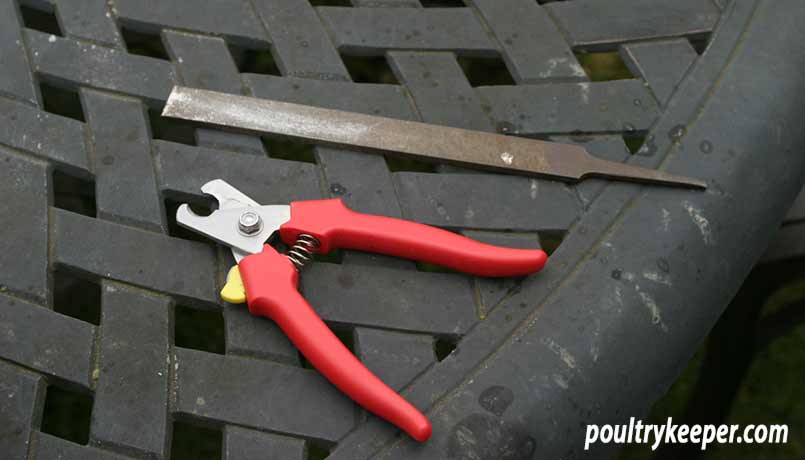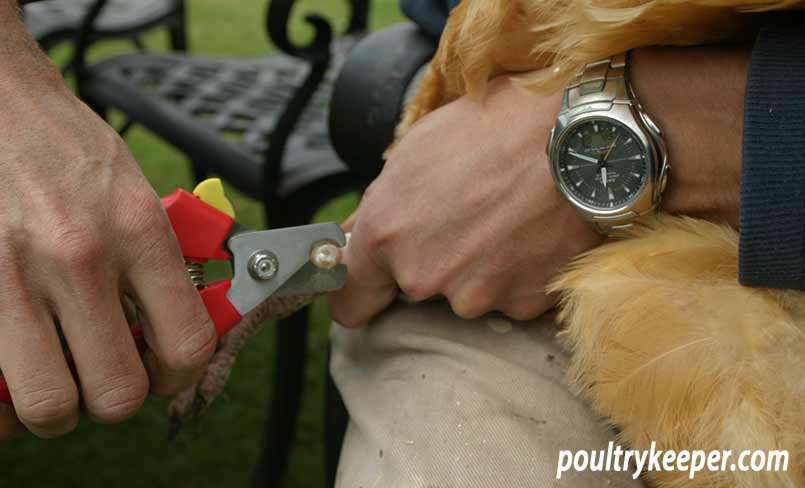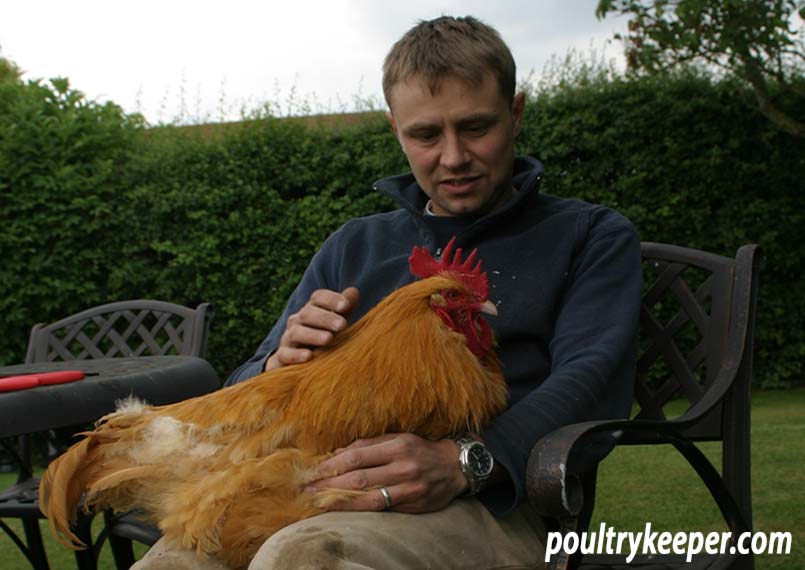
As roosters get older, their spurs grow longer, and some can become very sharp and pointed, causing damage to the sides of a hen during mating. This article will show you how to trim rooster spurs and what to do if spurs bleed if you cut too much off.
A rooster’s spurs gradually grow, and after a year or two, they may be an inch or two long. If you run a rooster in with your hens, he will mate with them during the breeding season. It involves holding on to feathers on the back of a hen’s neck and stepping onto her back for a few seconds while mating.
Claws and spurs can cause damage to the back and sides of your hens. While short spurs don’t usually cause harm, and we often use poultry saddles to provide some protection, excessively long spurs can easily tear the skin. It is a good idea to trim roosters spurs to keep them short, every so often.
We can miss the damage from spurs as the wings can cover up sore and torn skin. You should always inspect your hens regularly, and as soon as their favourite mates can be identified (or if you have a small number of hens running with a cock) they should have saddles fitted to protect their backs. If the skin becomes torn, the hen risks getting an infection.
We can trim spurs back and round the ends off and keep them to a suitable length, but similar to dog’s nails, we must not cut them back too far in one go, or they will bleed.
Hens with a spur wound
I have included a photo and information on how I have treated spur wounds in the drop down below. Not everyone will like seeing a wound, so if you’d rather not see it then scroll down instead of clicking on the drop down.
This wound was hidden under the wing of a Light Sussex hen.

This is an advanced technique, with risks. If you are in any doubt, please consult your vet.
With an open wound, there is a high chance of infection.
If the wound is kept clean, I have found it can heal surprisingly quickly.
It would be best if you separated the hen from the flock, put her in a clean puppy crate or small chicken house where it can be kept clean.
I use bottled spring water to wash the wound, spraying it with a syringe (without a needle) to remove any dirt. I trim feathers that are nearby. Then, I use Veterinary Wound Powder on the wound.
I use the syringe and water daily to wash the wound off. It helps to keep it moist, and within a couple of days, a new layer of skin will form.
If you take this approach, I urge you to check the wound carefully every day. If there is any sign of infection (grey skin, a foul smell), seek the help of a vet immediately because she will administer antibiotics to her.
One final word of caution. Do not try to stitch the skin together, and do not cover it. If you close the skin, it is likely to heal, closing in bacteria and become infected. The aim is to let a new layer of skin from underneath and push the bacteria out.
How to trim rooster spurs?
Trimming rooster’s spurs is easy enough, yet strangely I get a lot of people ask me how to trim rooster spurs. You will need a sharp pair of cutters to cut them, large dog nail clippers like these are ideal, or tool shops sometimes sell almost identical round wire cutters. You will also need a file for rounding the edges off afterwards.

Be careful not to trim too much off the spur. A blood vessel runs down the centre that should not be cut. It is usually ¾ of the way along the spur.
Trim the point, then keep nipping small pieces off millimetre by millimetre until you see a tiny dot of blood appear in the centre of the spur. It is the top of the blood vessel and is as far as you can go.
It is important to take your time, so you don’t end up with the spur bleeding.

If you reach the blood vessel and the spur is still too long, then you will need to wait a few weeks for it to withdraw a little from the end of the spur before trimming your rooster’s spurs again.
Using the file, you can round the edges of the spurs off to make them neat.

What to do if the roosters spur is bleeding
If you trim too far, the spur will bleed, and it will be challenging to stop bleeding (just like dogs nails).
A veterinary caustic (Silver Nitrate) pencil will stop the bleeding. They are cheap and last a long time, so I would encourage you to keep one in stock for when you are trimming rooster spurs. It can be dabbed on the spur’s end to stop the bleeding and is also useful when trimming chicken’s nails.
If you don’t have a silver nitrate pencil, then hold a piece of clean tissue onto the spur. It can take 10 to 15 minutes to stop the bleeding if it’s bleeding profusely.

Now you know how to trim rooster spurs. As you can see, it’s not too difficult and can be done in just a few minutes once you get the hang of it.
Your hens will be much happier now when he shows them some affection! Please let me know how you get on in the comments below.







